Episode 181: STS-88 - A United Dawn (First ISS Flight)
Table of Contents
The ISS era is upon us! Let’s learn about Zarya, the first module of the International Space Station, and bring it a buddy: Unity! With a Russian and an American module flying, the ISS will be born. In this episode we’ll wonder why it’s too quiet, why the wires are on the outside, and which teams were playing down in South America!
Episode Audio #
Photos #
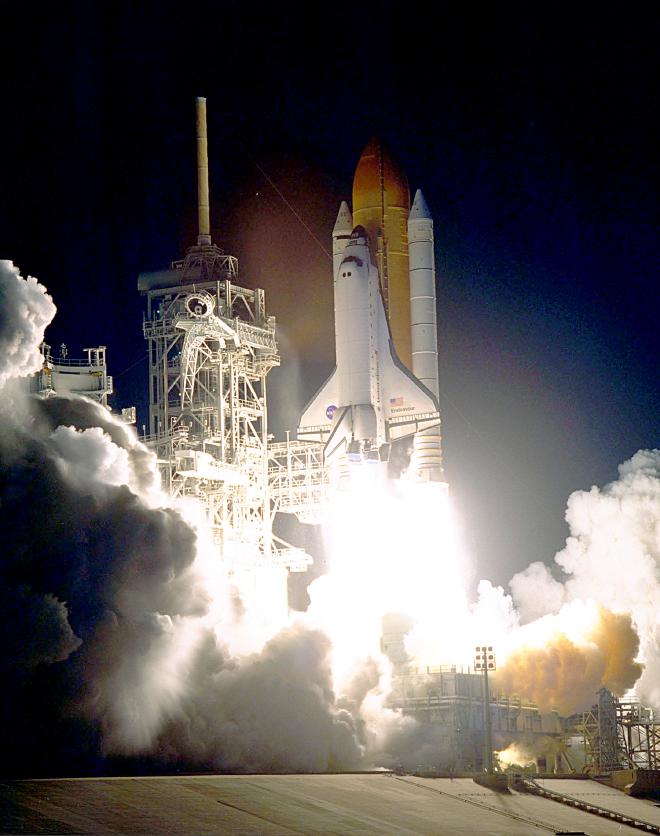
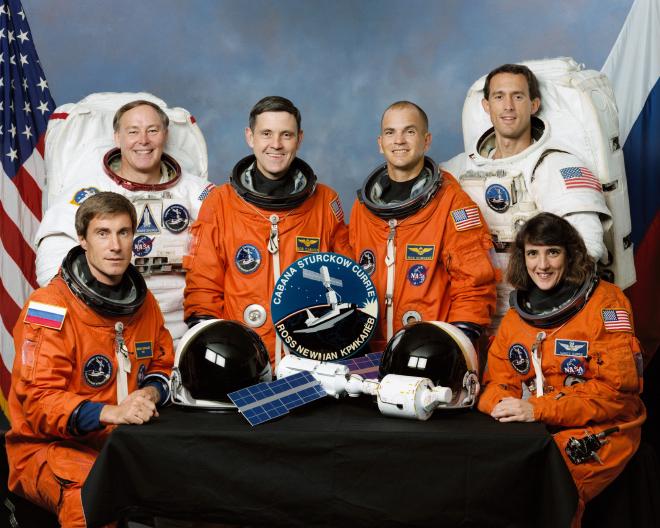
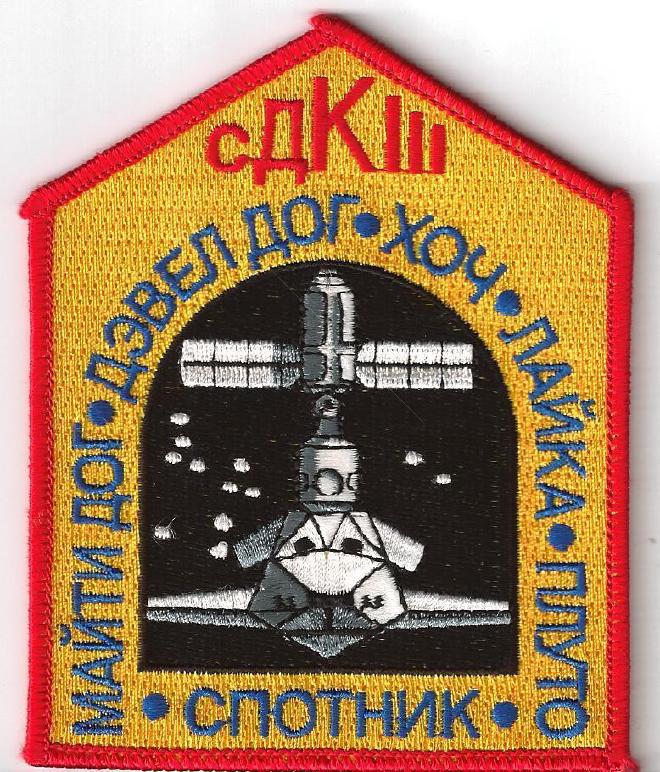
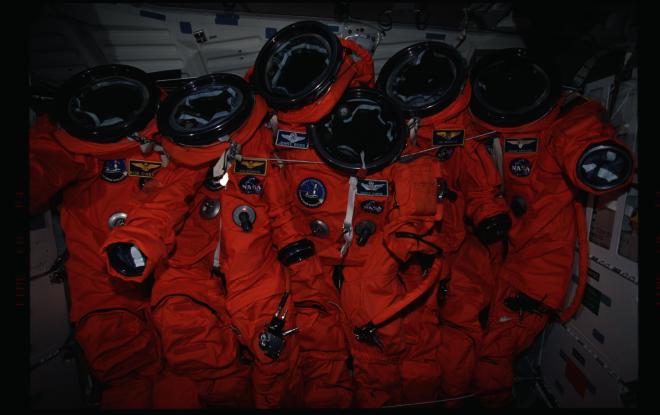
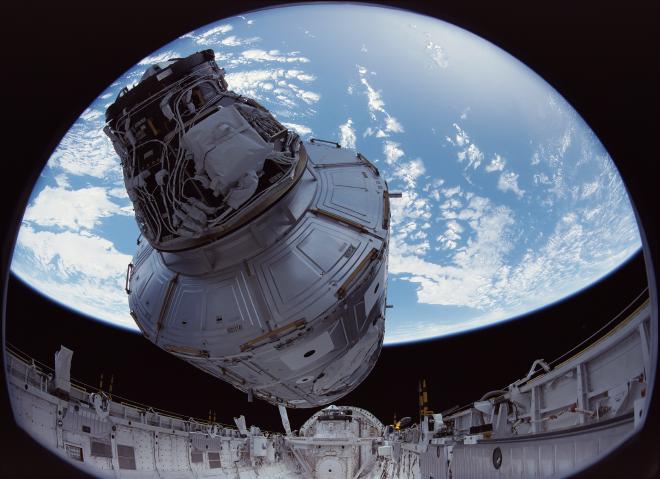
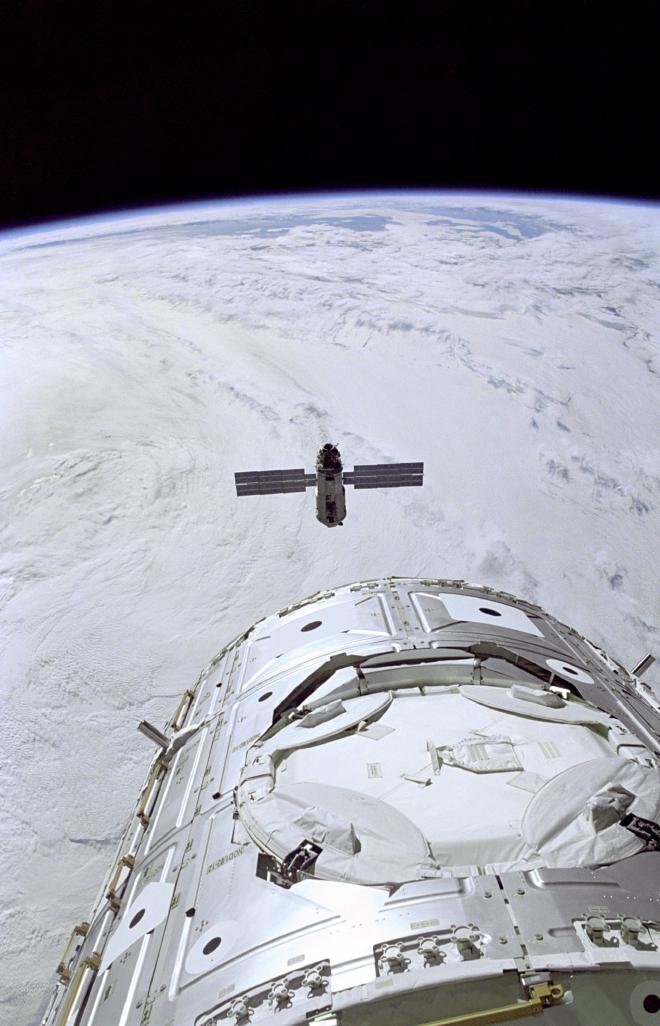
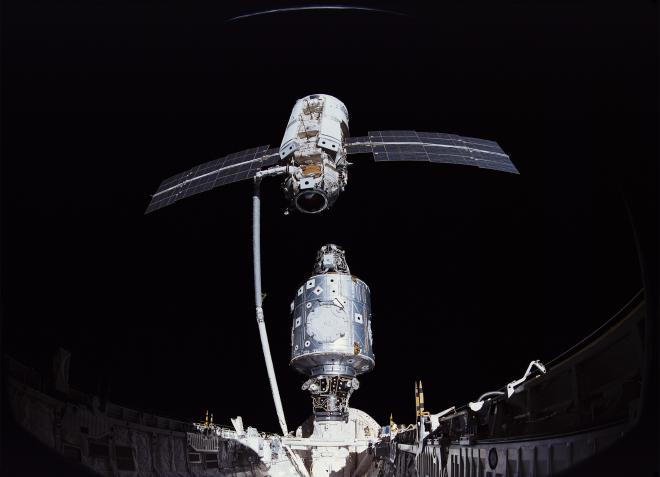
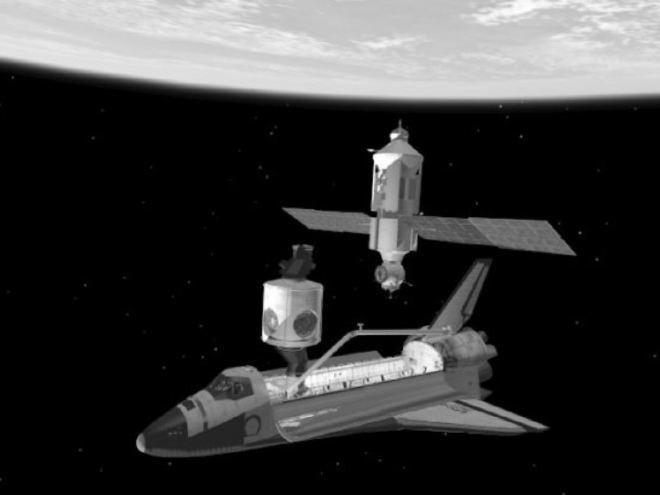
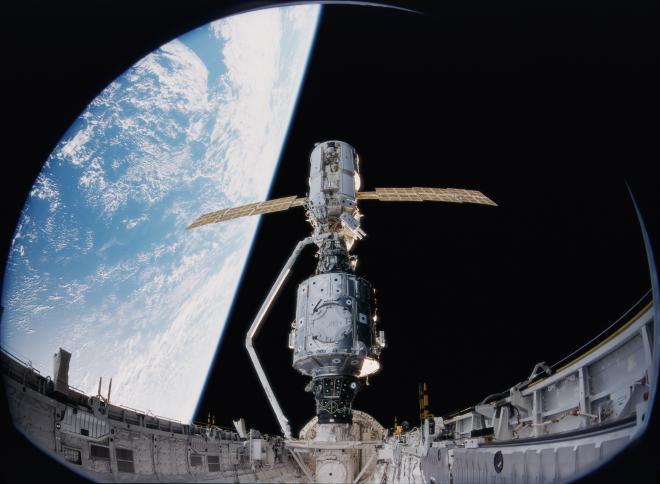
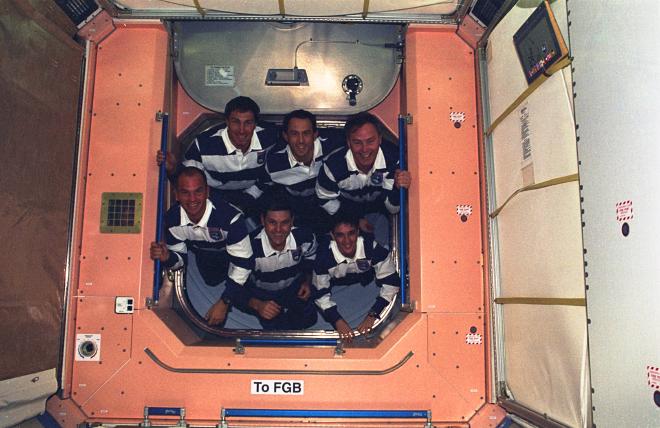
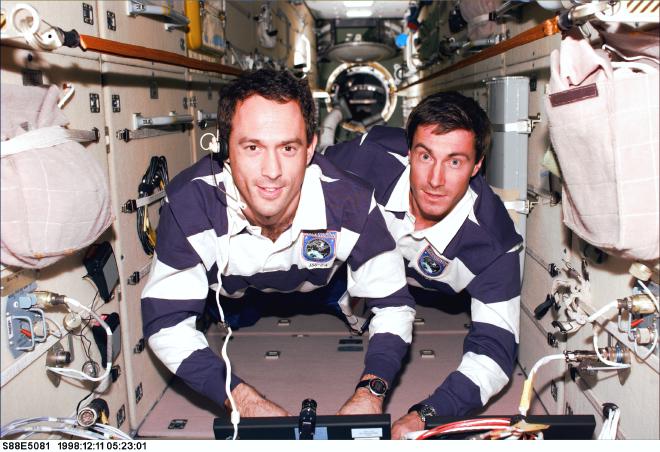
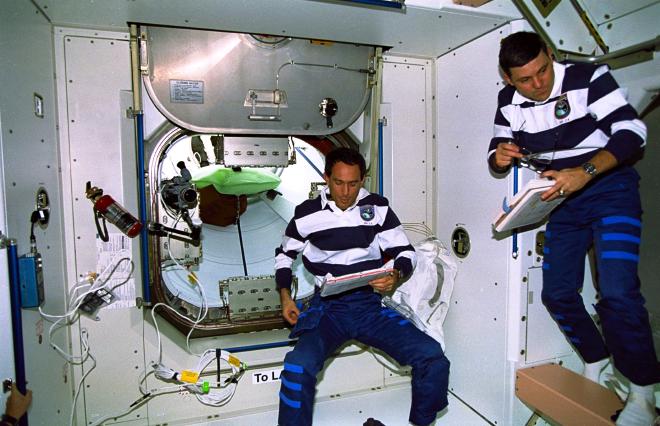
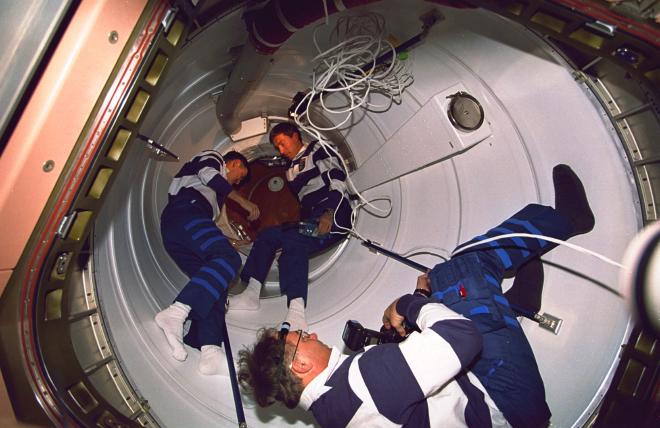
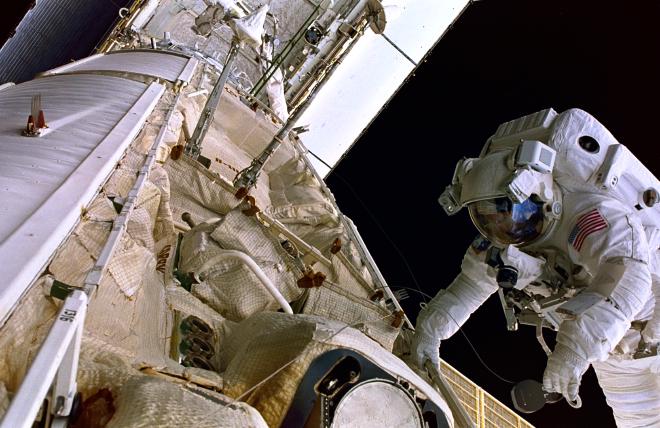
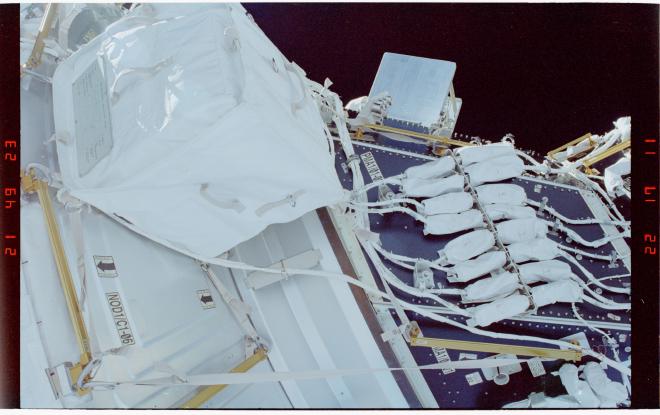
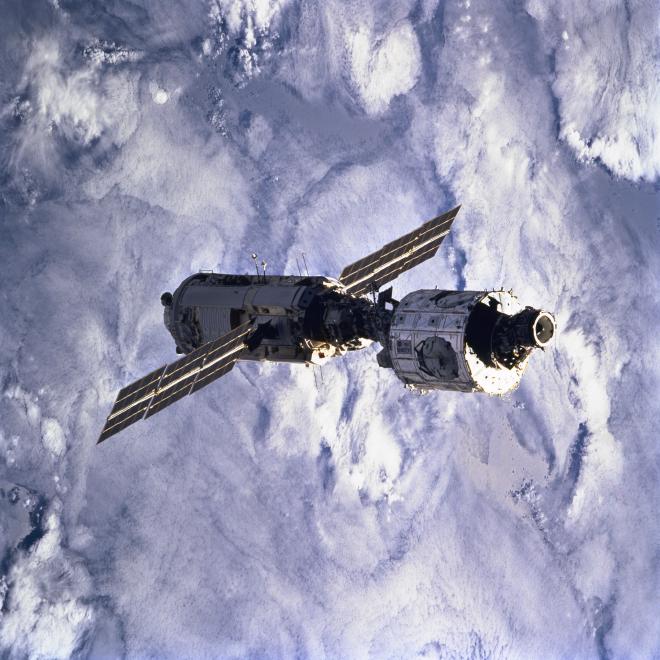
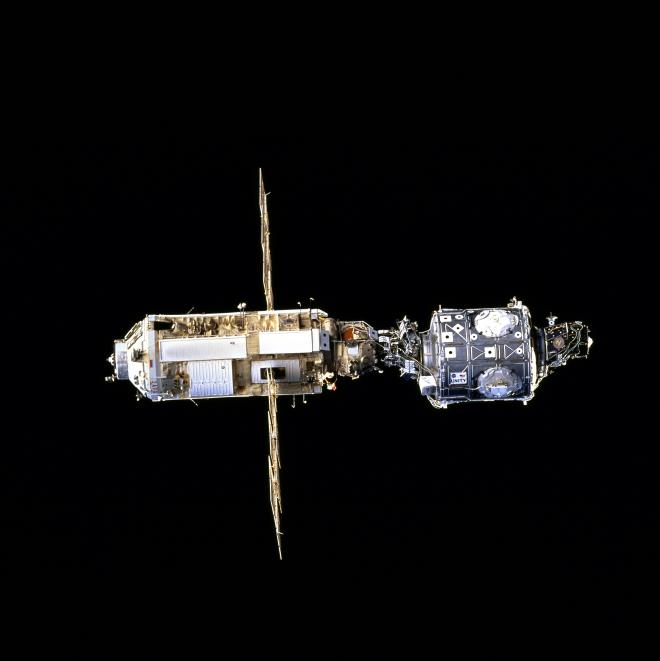
For more photos, head over to our friends at Wikiarchives.space: https://wikiarchives.space/index.php?/category/527
Post-Flight Presentation #
STS-88 Resource Reel #
Video Highlights #
Click here for full video details.
Click here for full video details.
Click here for full video details.
Transcript #
NOTE: This transcript was made by me just copying and pasting the script that I read to make the podcast. I often tweak the phrasing on the fly and then forget to update the script, so this is not guaranteed to align perfectly with the episode audio, but it should be pretty close. Also, since these are really only intended to be read by myself, I might use some funky punctuation to help remind myself how I want a sentence to flow, so don’t look to these as a grammar reference. If you notice any egregious transcription errors or notes to myself that I neglected to remove, feel free to let me know and I’ll fix it.
Hello, and welcome to The Space Above Us. Episode 181, Space Shuttle flight 93, STS-88: A United Dawn
Before we get started, I have a sort of silly correction to make. In the outro to the previous episode I mentioned how we would be discussing a rocket with the Pizza Hut logo on it today. Well, it turns out that I was off by one and that was the second Russian ISS module, not the first. Sorry about that! But it gives me a great chance to tell my favorite programming joke: in computer programming there are only three difficult things: naming variables, and off-by-one errors. Pause for uproarious laughter.
Oh and speaking of computer errors, I wanted to mention that I recently had an email bounced back to me and I discovered that my email server was slightly misconfigured. I mention this because if you have ever sent me an email and I didn’t respond, please know that it was not intentional! At the time of this recording I have responded to 100% of listener emails and plan to keep it that way. So if I never wrote back, please write again!
Last time, we flew a SPACEHAB mission with dozens of experiments conducting cutting edge research in a number of different fields. But the flight will forever be best remembered for the inclusion of Payload Specialist 2, former Mercury astronaut John Glenn. Glenn’s presence on this flight was a great excuse to think about just how far human spaceflight has come in really not all that much time. On his first spaceflight, Glenn splashed down in the ocean less than five hours after lifting off. On STS-95, the crew was barely even getting started at the five hour mark. On Friendship 7, Glenn flew alone. On STS-95, a single spacecraft launched the same number of people as all of Project Mercury combined. Glenn’s inclusion was also appropriate since I’m not sure there was a more poetic way to mark the definitive conclusion of the old space era and usher in humanity’s next spaceflight mega-project: the International Space Station.
Yes, after years of referring to its imminent arrival, the International Space Station is finally here. On a bit of a meta note, I wanted to mention that I’ve been thinking about how I want to handle my approach to the ISS. But in doing so, I realized that once again the show is mirroring the very history that we’re learning about. Phase 1 of the ISS, better known as the Shuttle-Mir program, was all about getting NASA better prepared for the monumental task of constructing and operating our new home in low Earth orbit. But at the same time, talking about Shuttle-Mir has prepared all of us for the monumental task of learning about the ISS. Obviously things will be different than the Mir days, but we already have a good understanding of how the ISS evolved from NASA’s struggling effort to create its own space station in the late 1980s and and early 90s. We already heard about how the fall of the Soviet Union created a great opportunity to work together with our former enemies, creating friends in the process, and allowing us to benefit from their vast space station experience. We are already familiar with multi-module space stations and how to navigate their twists and turns. In short, I think we’re ready to go.
So rather than making a standalone episode dedicated to introducing the ISS, I’m going to simply refer you to the Shuttle-Mir episodes. And rather than spelling out the entire overall Station plan right at the start, I think it will be more fun to learn about it piece by piece, really getting to see how each individual module, truss, or other support equipment fit into the overall picture.
So! With all that said. Let’s get right into it and discuss the very first component of the International Space Station: Zarya.
Zarya, which is Russian for “dawn” or “sunrise”, and is more formally known as the Functional Cargo Block, or in its Russian acronym the FGB, was the heart of the early ISS. Also, get used to that, I’m finding that most parts of the ISS have a few different names, so I’m going to be using “Zarya”, “the Functional Cargo Block” and “FGB” interchangeably. Originally built as a module for Mir, Zarya would be the early source of electrical power, propulsion, and attitude control for the nascent Space Station. Sort of counterintuitively, it was paid for and actually owned by NASA, but I think it’s safe to still think of it as the first Russian module on the station.
The FGB was actually ready to fly around a year before today’s mission, in late 1997, but ISS construction was held up due to the delay of another module we’ll talk about in more detail later: Zvezda. Zvezda, Russian for “Star”, will be the Service Module for the ISS, and was required before crews could move in, so its delay shifted everything down the timeline. But that’s a story for another episode.
On November 20th, 1998, perched atop a Proton rocket that was completely devoid of Pizza Hut logos, Zarya lifted off from the Baikonur Cosmodrome and the ISS era was upon us. Let’s meet the crew that would be the first to see it up close on orbit.
Commanding the mission is our good buddy Bob Cabana. We know Cabana from a few flights, but most recently we saw him commanding STS-65, the IML-2 flight. And since this is my last opportunity to do so, I will remind you once again of the time that he fastened the IML mission flag around his neck like a cape, proclaimed himself to be IML-Man, and flew across Spacelab. Incidentally, at the time of this recording Cabana is the Associate Administrator of NASA, so every great once in a while I hear about him weighing in on some top level decision related to the mission I work on for my day job, and I’m always like “.. my job is being affected in any way by IML-Man? Whoa.” Anyway, this is Cabana’s fourth of four flights.
Joining Cabana up front was today’s pilot, and lone rookie for this flight, CJ Sturckow. Frederick Sturckow was born on August 11th, 1961 in La Mesa, California, but grew up in nearby Lakeside, California. He earned a bachelor’s degree in Mechanical Engineering from California Polytechnic State University and then signed up with the Marines. It was there that he learned how to fly the F/A-18 fighter jet and was deployed to Japan, Korea, and the Philippines and also including a trip through the Navy Fighter Weapon School aka TOPGUN. Sturckow has extensive combat flight experience, flying 41 missions as part of Operation Desert Storm and serving as mission commander for 30 airstrikes in Iraq and Kuwait. After that he graduated from the US Air Force Test Pilot School and was working as a test pilot at the Naval Air Warfare Center at Patuxent River, Maryland when NASA came calling in 1994. Sturckow sometimes went by Rick, short for Frederick, or more often, CJ, which was short for Caustic Junior. He would be quick to point out that this was not a reflection of his personality, but rather the fact that he apparently resembled a squadron commander who went by the nickname Caustic. Hence Caustic Junior, CJ. This is Sturckow’s first of four flights with the shuttle, but at the time of this recording he also has piloted four missions for Virgin Galactic. And depending on who you ask, those are spaceflights too. I say let’s give them to him.
Sitting behind Sturckow was someone who at this point should just be paying rent: Mission Specialist 1, Jerry Ross. We, of course, are very familiar with Ross, who is one of the few pre-Challenger astronauts who is still flying. We last saw him flying on STS-74, which delivered the Docking Module to Mir. Today marks his sixth of seven flights.
Sitting in the middle of the flight deck was Mission Specialist 2, and today’s flight engineer, Nancy Currie. In the past I’ve referred to Nancy as Currie-Gregg, which is her name now, but it turns out the “-Gregg” addition actually came later. I’m not exactly sure of what the right way to handle that situation is, but all of the documentation and interviews related to this story call her Nancy Currie, so that’s what we’re going to do today. We know Currie from her flight on STS-70, which saw the final shuttle-based deployment of a TDRS satellite, sending TDRS-G on its way to the GEO ring. On today’s mission she’ll be doing a lot of work with the robot arm and with elements of the ISS on that arm she’ll be working with a payload that a few more people have heard of than TDRS-G. This is her third of four flights.
Moving downstairs, we find Mission Specialist 3, Jim Newman. When we last Newman, he was flying on STS-69 which saw the second flight of the Wake Shield Facility, everybody’s favorite low Earth orbit epitaxy tech demonstration mission. Today he’ll be heading outside with Jerry Ross on this, his third of four flights.
And last, but certainly not least, Mission Specialist 4, Sergei Krikalev. Of course, we know Krikalev from STS-60, which was the first flight of the Wake Shield Facility, and also counted as the first Shuttle-Mir flight. They didn’t go anywhere near Mir, but they did have a Russian on board, which I guess was all it took. Krikalev was a pretty late addition to the crew, only joining everyone else around five months before liftoff. I’m not entirely sure why this was the case but it sure seems like someone suddenly realized that they were flying to the International Space Station and didn’t have anyone from NASA’s primary partner flying along. It was a lucky break for both Krikalev but also for the mission, as we’ll see later.
These six men and women will forever be known as the crew that ushered the ISS into orbit, but there’s another reason that this crew stands out, and one that is far more fun and far far stupider. STS-88.. is Dog Crew III. Keen-eared listeners may have already picked up on this. The flight’s commander, Bob Cabana, was the pilot on STS-53, the original Dog Crew, where he earned the nickname “Mighty Dog”. Jim Newman served on STS-69, Dog Crew II, and picked up the name “Pluto”. When Newman realized there were two former Dog Crew members on the flight he came to Cabana and said they had to do Dog Crew III. Cabana was concerned about being a little too silly on a flight of such importance and wasn’t sure it was a great idea. But Newman persisted so eventually Cabana agreed to become the Stealth Dog Crew.
And they really went all out on this. They went to retrieve Dave Walker’s Dogmobile, which I’m sure you’ll recall was a 1978 Pontiac with some old airplane parts glued to it, but found it too decrepit to repair. One day Cabana came over to Sturckow’s place and discovered the pilot had apparently made a ton of progress fixing the vehicle up. Nope. Instead, Sturckow had spotted a visually similar 1978 Buick for sale for 600 bucks and bought it, transferring stuff over from the original Dogmobile, including the T-38 wingtip that was used as a Shuttle-like tail. So that’s how Dog Crew III came to have Dogmobile II.
Of course, we also get some new names! CJ Sturckow was a Marine, and Marines already have the nickname of “Devil Dogs”, so Devil Dog it was. Jerry Ross was named Hooch after the dog in Turner and Hooch, apparently for his lovable and loyal qualities. Nancy Currie was given the name Laika, I guess cause they were both females who flew in space. Currie protested, pointing out that Laika died in space, and instead suggesting Strelka, a later female Russian space dog who successfully returned to Earth and had puppies. But, as Cabana explained in an oral history, you don’t get to pick your own dog name. Jim Newman was already Pluto, which left only Sergei Krikalev, aka.. Spotnik.
The crew apparently took to driving around in the newly christened Dogmobile II, arriving at events in what they called “style”. But somehow Nancy Currie, aka Laika, always had a valid excuse for why she couldn’t join them. As Jerry Ross put it in his book Spacewalker, “Laika, being a smart woman, wanted no part of the dog car.” Not to be deterred, one day the rest of the crew parked the car at the exit to the building they knew she was working in and when she came out she discovered them there with the engine running and the door open. Ross said “She went along with the fun and only barked at us a little.”
But on to less stupid things. The first launch attempt hit a snag when the orbiter reported it had low hydraulic pressure, which would have prevented it from moving its control surfaces, leading to a hold at the T-31 second mark. The problem was determined and resolved, but not before the narrow launch window dictated by the ground-up rendezvous expired. They had missed it by just a few seconds, leading to a 24 hour recycle. The next day, the count proceeded smoothly, and on December 4th, 1998, at 3:36am Eastern Standard Time, Space Shuttle Endeavour lifted off for its date with spaceflight history.
After an uneventful ascent, the crew opened the payload bay doors, wriggled out of their launch and entry suits, and began checking out their equipment for the complex mission to come. As pointed out by Steve Francois, the head of Space Station and Shuttle Payload Processing at the Kennedy Space Center, currently riding in Endeavour’s payload bay was America’s first new human-rated spacecraft since 1981. OK, we may have introduced new orbiters since then, but they were all the same design. No, today we have something new: the first American module for the International Space Station, Unity, more formally known as Node 1.
As the name suggests, Unity would be playing a similar role on the ISS as the node did on Mir, being a central connection point for multiple modules. It’s essentially a big cylinder, 4.5 meters in diameter and 5.5 meters long, with a specialized mechanism on each end and four around the main body of the cylinder. These mechanisms, called Common Berthing Mechanisms, or CBMs, are how the modules on the non-Russian side of the ISS would be connected to each other. So Unity was basically a big metal can with connections all over it so later it would be possible to connect specialized modules to it.
Currently attached to the two Common Berthing Mechanisms on both ends were Pressurized Mating Adapters, or PMAs. The CBMs were great for connecting semi-permanent ISS modules, but they were not great for docking spacecraft. That takes specialized hardware like shock absorbers, mechanisms to guide and fix alignment, power and data connectors, and so on. This is where the Pressurized Mating Adapters came in. A PMA was basically a CBM connection on one side and an APAS connection on the other. Oh yes, welcome to acronym town. If it’s floated out of your memory, APAS is the Androgynous Peripheral Attach System, and is the docking system compatible with both American and Russian spacecraft. With a PMA on each end, Unity was 11 meters long and weighed in at about 11,600 kilograms. Which in more down to Earth terms is about nine times as much as my car.
Alright that was a lot of information so I’m going to take one more run at that, just to help it stick. Unity, aka Node 1, is a big cylinder with six connection points, called Common Berthing Mechanisms, stuck all around it. On the longitudinal CBMs are two Pressurized Mating Adapters, or PMAs, which can dock with American or Russian spacecraft. It’s a structure that we can attach more modules to later as we begin to build out the ISS.
While life is always busy on the Shuttle, with equipment being checked out, rendezvous maneuvers being executed, and plenty of housekeeping, the first major event doesn’t take place until Flight day 3: preparing Unity for docking. This will actually follow a very similar process to how we handled the Mir Docking Module back on STS-74, but much bigger. Mission Specialist Nancy Currie operated the Shuttle’s robotic arm and grappled the bulky module. The goal was to raise it up out of the payload bay, rotate it 90 degrees so it’s upright, and then position it above the Orbiter Docking System. But this was actually a pretty tricky task. You may have noticed that I mentioned that Unity was four-and-a-half meters in diameter, or fifteen feet. But you may have also remembered that the diameter of the Orbiter payload bay is.. also fifteen feet! I guess a little rounding was being done somewhere with those numbers, because Currie had something like an inch of clearance on both sides, or two and a half centimeters. But that’s really not much room. Cabana later said that he didn’t even know the arm could move that slowly, and that watching Unity emerge up on the arm was like watching grass grow.
After around an hour and a half of watching grass grow, Unity was positioned vertically in the payload bay, with PMA-2 directly above the Orbiter Docking System. At this point, Currie commanded the robot arm to go limp, and Commander Cabana fired Endeavour’s thrusters to sort of run over the module, providing enough force for the docking mechanisms to engage. After the system retracted and rigidized, the first major operation of the mission was complete.
This is also a great opportunity to mention one of the many things in spaceflight that can easily be glossed over without the full difficulty being expressed to the listener or reader or whatever. Think about the configuration Endeavour is now in. Endeavour itself has a mass of around 78,000 kilograms, and now there’s this other thing with a mass of nearly 12,000 kilograms sticking straight out of it. And that’s only going to get worse once we dock with Zarya, more than doubling the length and the mass of this thing sticking straight out of the payload bay. That’s a lot of leverage. It meant that the center of mass of the Orbiter was significantly different than normal, and certain assumptions made by the flight control software were no longer valid. So just to be able to fly like this and perform rendezvous maneuvers and maintain a desired attitude required significant work from folks on the ground as well as extra care from the crew. It was possible to drift far enough away from a desired attitude and attitude rate that the small vernier RCS thrusters wouldn’t be able to keep up in this configuration, which would engage the primary RCS thrusters, which were powerful enough to maybe snap Unity right off. Again, this problem was foreseen and dealt with, which is why stuff like this usually doesn’t get mentioned, but I thought folks might be interested to know.
Flight day four was the big day. Rendezvous day. This was a somewhat unusual and tricky rendezvous, but the final approach started with a nice and familiar swoop down underneath Zarya. Once on the R-bar, Endeavour began making its way up, approaching the Russian module. But at a range of 76 meters, Cabana fired the thrusters to move out in front of Zarya, tracing out a big 76 meter circle, and continuing until Endeavour was above Zarya. So instead of a +R-Bar approach, this was a -R-Bar Approach, flying down from above. The extra flying was required since Russia was relying on ground stations to maintain contact with Zarya, so if Endeavour approached from below it would be right in the way of Russian antennas. No good.
Once on the -R-Bar, Endeavour was worked down until Zarya was within range of the robot arm, and the crew began to stationkeep for seventeen minutes until the two spacecraft flew over Russia and Russian ground control could reestablish contact. And here’s where we encounter another difficulty. Normally during a final approach like this, and especially during stationkeeping, a Shuttle commander relies on the view out the four big windows at the aft of the flight deck. But for this flight.. there’s a big giant space station module blocking the view! Unity was in the way! Since this had been long anticipated, the Orbiter Docking System was actually mounted slightly further back in the payload bay, the only ISS mission to do so, hoping to give the crew a bit more of a view. But really, they had to rely entirely on the views from various cameras in the payload bay and the one on the end of the robot arm. Theoretically the Orbiter Space Vision System, or OSVS, was also there to help. Remember that? It’s the system that looked at big black and white dots stuck all over a spacecraft to help determine their position and orientation. Well, this was what it had been designed for. Unfortunately, I couldn’t find a lot of detail, but the crew said it did not work great and did not perform satisfactorily, so it all came down to a few cameras. Cabana had to get through seventeen minutes with a giant Russian space station module hanging nearly directly in the payload bay, with no great view of it since it was hiding behind Node 1. And I mean, it was right there, with the bottom of Zarya closer to the shuttle than the top of Unity.
This situation went from tricky to terrifying when suddenly Cabana realized that Zarya was moving down into the payload bay. He fired the thrusters to back Endeavour away, and.. nothing happened. Uh oh. OK, let’s take a step back a few seconds and see what just happened.
During a stationkeeping situation like this, Cabana could move Endeavour from side to side with the translational hand controller in his left hand, or he could rotate it with the rotational hand controller in his right hand. That’s six degrees of freedom: up and down, left and right, forward and backward, pitch, roll, and yaw. That’s a lot to keep track of so he did what any Shuttle commander would do and engaged an automatic attitude hold mode. That meant that as long as the Orbiter was within a certain range of the desired attitude the computer did nothing, but when it drifted a little too far away the computer would fire a thruster and rotate the Orbiter back into position. And that’s what just happened. OK great. Except Endeavour is a real world spacecraft, not an idealized one out of a textbook. When the computer fired the thrusters to rotate the Orbiter it also resulted in a small amount of translation, moving the Orbiter relative to the target. In this case, it was if the command had been to move up slightly with respect to Zarya.
Cabana saw this and reacted by firing the thrusters to move down with respect to Zarya and nothing seemed to happen. Well, there’s a reason that they make the commanders practice, and it’s for situations like this. Cabana realized that he was in B-DAP mode, which was a set of pre-configured behaviors for the digital autopilot, or DAP. In this case, B-DAP was set to make small gentle motions, appropriate for delicate stationkeeping, but not so much for dodging Russian space station modules. So he looked down at the ORBITAL DAP SELECT section of the control panel just below the aft window, punched the A-DAP button, and was able to safely back away, only then slowly making his way back to gently re-approach the FGB and resume stationkeeping.
Cabana recalled this story in an oral history interview in 2015 and pointed out how normally, Jim Newman would be pretty vocal during a rendezvous. Since his pre-astronaut job was actually training astronauts for rendezvous, he was quick to give little pieces of advice. After Cabana had safely recovered after this little scare he realized that the cockpit was completely silent. He said to Newman “Hey Pluto, how come you didn’t have any advice for me there?” Newman replied “Well, I know when to keep my mouth shut.”
Eventually contact with Russian ground stations was re-established, the crew were given the final go-ahead, and at a mission elapsed time of 2 days, 15 hours, 12 minutes, and 28 seconds, Nancy Currie successfully grappled Zarya. The FGB was the heaviest payload ever grappled by the Shuttle robot arm across the entire 30 year history of the program, tipping the scales at around 19,000 kilograms. Just to keep my silly comparison from earlier going, that’s about fifteen times as much mass as my car. Just like how Unity had been positioned above the ODS, Zarya was positioned a few inches above PMA-1 at the top of Unity, the robot arm was set to limp mode, and Cabana fired Endeavour’s thrusters, pushing it up into the Russian module for capture, and the first connection of the International Space Station was made.
During the rigidization process, which takes a good chunk of time after the initial soft dock, the ground noticed that the FGB was getting slightly out of alignment. Ross, recalling a similar issue on STS-74 with the Mir Docking Module, said that it was the robot arm slightly pulling it to one side. Currie was reluctant to disengage, saying “I’m not letting go of it now that I’ve got it” but the ground soon confirmed this was the issue and she reluctantly released the Russian module. Sure enough, that was it, and hard dock was soon achieved. At the time of this recording, it’s still docked, nearly 25 years later.
The next day, the really hard work began. Mission Specialists Jerry Ross and Jim Newman suited up and climbed out of the airlock. Remember how in the frantic moments after Progress M-34 crashed into the Spektr module on Mir, the crew were using a kitchen knife to saw through a bunch of sparking electrical cables so they could close the hatch and seal off a rapidly leaking module? Yeah. Well. NASA wanted to avoid that sort of situation on the ISS. So a common task on ISS spacewalks will be connecting cabling from one part of the station to the other, on the outside. Part of me wonders if they maybe could have had some smaller, easy to seal conduits dedicated to wiring on the inside, but hey, I’m no space station designer. If anyone listening can explain why all the cables we’ll be talking about couldn’t be run inside, please let me know.
But anyway, cables. The first task was to attach eight cables between PMA-2 and Unity, and then another eight cables between Unity and PMA-1. You might ask, as I did, why this wasn’t done on the ground where it’s much much easier, but Unity was packed so tightly into the payload bay that there just wasn’t room for a bunch of external equipment. Next up was making a further twenty-four connections between PMA-1 and Zarya, up at the top of Unity. This established data connectivity between the modules and also allowed electricity to flow from Zarya to Unity, which had no solar panels of its own. While they were out there, Ross and Newman also installed a bunch of handrails and other equipment that would make future spacewalks simpler.
At one point in the EVA, Newman was raised up on the RMS to take a look at a stuck TORU antenna on the FGB. Oh god, we really are swimming in acronyms now. Anyway, TORU, as you’ll recall, is the system that allows cosmonauts to take manual control over an approaching Progress spacecraft. Telemetry indicated that both antennas had released their launch restraint pins but they didn’t seem to be working. Newman inspected the situation and confirmed that the pins had indeed been released, but the antennas were just sitting there, all curled up. Russian mission control got to work thinking of a solution.
After seven hours and twenty-one minutes of connecting cables, installing handrails, removing dust covers, double checking data connectors, and so on, Ross and Newman headed back inside.
The next day, the spacewalkers could take it easy and recover, but there was still work to do. As we’ve talked about, spacecraft in low Earth orbit experience a small amount of drag, which over time causes their orbits to sink lower and lower. One of Zarya’s roles in the early ISS would be to use its propulsion system to boost the station’s orbit, but that propellant was precious, and there just so happened to be a giant orbital spaceplane attached to station at the moment, and it had a propulsion system of its own. So over the course of around 23 minutes, Endeavour fired its thrusters and raised the orbit of the combined structure by around 8 kilometers, ending up in a 398 by 390 kilometer orbit.
But I think we can do better than that. How, exactly did it fire its thrusters? The OMS engines would be way too powerful and would likely wrench Unity’s PMA right off the Orbiter Docking System. So the job fell to the primary RCS thrusters, but they came with their own difficulties. In order to keep things under control, the burn was actually split up into a number of pulses. First, two RCS thrusters on the back of the Orbiter fired for five seconds, but since we have the ISS sticking out of the payload bay and since thrusters aren’t perfectly aligned, that would cause the entire structure to start pitching down at around one degree per second. So after the five second pulse from the PRCS, eighty seconds was spent using the small vernier thrusters in the nose of the Orbiter to push the Orbiter’s nose back up, canceling out the pitch rate and building up a smaller pitch rate in the other direction. Then Endeavour was allowed to coast for fifty seconds, rotating until it was back in its starting position and the whole process could start all over again. Repeat that 135 second sequence eleven times and we get 24 minutes and 45 seconds, which is pretty close to the 22 minutes and 47 seconds actually spent doing the reboost maneuver. I think the discrepancy is because the final pulse wouldn’t have to spend so long rotating into position for another pulse. So there you go, now you know how to raise the orbit of the ISS.
Alright now that we’re settled into our slightly loftier perch, it’s time to move to the next day, which saw the second spacewalk of the mission. Ross and Newman once again suited up and got to work on the exterior of the station. A number of different tasks were on the docket today, and I didn’t bother writing down what order they came in this time, so we’re just going to get into it. The duo installed a pair of temporary S-band antennas on the side of Unity, which would allow it to communicate with TDRSS, giving the ground the ability to keep an eye on it and command it. The EV crew also freed one of the two stuck TORU antennas by using the highly advanced technique of reaching out and poking it with a long stick. With a little literal prodding, the antenna suddenly unfurled, sort of like a party noisemaker or a reverse slap bracelet, sending a small piece of restraint hardware rocketing off into the void.
And if that wasn’t goofy enough, at one point Ross and Newman had a little unexpected radio chatter in their helmets. As they soared a few hundred kilometers above South America they suddenly started hearing someone speaking rapidly in Spanish. It wasn’t really clear what was happening until suddenly the voice said “GOOOOAL!!!” They were somehow picking up a radio broadcast covering a soccer game somewhere down there. Ross said that he thinks it’s the only time in Shuttle history that something like this happened. Makes me think of those guys at that Dutch airport radioing things up to the Mir spacewalkers.
One EVA task was, on the one hand, just a little bit of get-ahead housekeeping to save time for a future EVA crew, but on the other hand was a pretty symbolic act. The data cable that ran up from PMA-2, along Unity’s side, and to PMA-1, controlling the docking system on PMA-1, was removed. With this being a permanent connection between the US segment and the Russian segment, there was no need to be able to control the docking system between PMA-1 and the FGB. NASA and Russia were in this together. With antennas installed, other antennas unrolled, cables packed away, and soccer goals noted, the spacewalk ended after seven hours and two minutes.
On flight day eight it was the time for the moment everyone had been waiting for: ISS ingress. Commander Cabana had received a lot of questions from the media about who would be first to enter the space station, but he never gave them, or even the crew, an answer. But that didn’t mean he didn’t have a plan. When the time came, he said “Sergei, come up here”, waving the cosmonaut over. And that’s how it was that on December 10th, 1998, at 19:54 GMT, an American and Russian entered the ISS for the first time, side by side. This was actually sort of an involved process. The crew would eventually explore the entire length of the station, but that required opening six different hatches: one between Endeavour and the ODS, then the hatch into PMA-2, then into Unity, then into PMA-1, then into Zarya’s Pressurized Adapter, and finally into Zarya’s Instrument Module, which was the main compartment. And it’s a good thing that Krikalev was there. Thanks to his lengthy stays on Mir, he knew exactly what to expect once they entered Zarya, and right away said something was wrong. The rest of the crew asked how he knew and he said it sounded wrong. It was too quiet. Sure enough, he then found a forgotten piece of plastic in an air duct that was blocking some airflow. Assisted by Currie, Krikalev also made quick work of replacing a battery power regulator that was acting a little wonky. Experience pays off!
There was quite a visual contrast between the Russian and American modules. Zarya, with its extensive storage areas hidden behind removable panels, felt much more cramped, even if it was actually quite a bit bigger. It also had a consistent green coloring theme everywhere that, to my eye at least, is sort of a sickly unpleasant shade, but I guess that’s why I’m not a cosmonaut.
By contrast, Unity was almost blindingly bright and white, and felt much roomier. But not wanting to be too blindingly white, and perhaps recalling lessons from Skylab, some elements, like some beams and the entire bulkhead leading to the FGB, were a nice soft coral color. Unlike the node on Mir, Unity was slightly elongated, providing room for four standardized equipment racks, which could be used for everything from science, storage, or even crew quarters. It also helped that it wasn’t crammed full of cables and ducts running from module to module.
In his book Spacewalker, Jerry Ross talked about how he was in the same astronaut class as Mike Smith, the pilot on STS-51L, so before this flight he had talked to Smith’s widow to ask if it would be ok to put a TFNG patch on the ISS in his memory. She thanked Ross for the thought and said that she and her family would appreciate it. This sent me on a forty minute hunt through as many photos of Unity’s interior as I could find, looking for the patch. When I finally gave up, the very next sentence in the book explained that Ross had stuck it behind one of the panels. You got me, Jerry. But also, what a nice thought. It may have been 68 flights ago, but the shadow of Challenger was still there.
And I wasn’t the only one having trouble with the panels. Cabana, Sturckow, and Currie were removing some panels and installing equipment when they lost a pin, which slipped back behind a panel. They spent an hour looking for it but never were successful. So we’ve been in the ISS for only a handful of hours and we’re already losing stuff!
Since Unity was still pretty barren, only accumulating layers of equipment on every surface on later flights, the crew decided to have a little fun. Nancy Currie allowed herself to be positioned right in the center of the module, out of reach of any surface. She then proceeded to attempt to flail her way to a solid surface, which Ross compared to looking like a cat trying to swim in water. Since I know there is footage online of this exact same thing but in the Japanese Kibo module, I wonder if every crew who opened a new module did the same thing.
One especially profound moment took place late that night. Well, late into the crew’s sleep period, but that’s not as poetic. Jim Newman had a habit of staying up a little later than the rest of the crew, catching up on emails, enjoying the view out the window, and so on. That night, when everyone else was asleep, he drifted down from the flight deck, through a dark middeck, down the tunnel, and up through the Orbiter Docking System to the ISS for a look around. It was there that he found Bob Cabana and Sergei Krikalev inside Node 1, passionately discussing the future of human spaceflight. They were discussing what the future meant to them and how important the Space Station was going to be in that future. As Cabana tells is, they stayed up until four in the morning just talking about this exciting moment that they had played their own critical part in. I think for some astronauts, their time with NASA is an opportunity to prove that they can take on any challenge, or a stepping stone to other careers, and I don’t begrudge them at all for that. But it’s clear to me that Cabana and Krikalev are hardcore believers in the critical importance and central role spaceflight holds for our future. So I thought this was a pretty awesome moment.
Eventually, the trio called it a night and headed back to the middeck for a few hours of sleep. The next day, perhaps a little bleary-eyed, the crew prepared to seal off the ISS. Cabana says that they left behind a gift for the next crew but refused to say what it was, so maybe we’ll find out next episode, or maybe it’ll be a fun astronaut-only secret. In any case, after 28 hours and 32 minutes of being open, the hatches to the ISS were closed.
The next day, flight day ten, it was time for the third and final spacewalk. This EVA was a little bit of a mishmash of different tasks, primarily focusing on some minor repairs, some get-ahead tasks, and a tech evaluation. First, the EV crew deployed the second stuck TORU antenna, again using the “poke it with a long stick” method. I’m not sure why they didn’t just do both at once, but maybe they were worried about damaging the antenna so they figured they’d try it with just one and see how it went. Ross also noticed that an experiment on the exterior of Zarya was mounted improperly and would likely come loose soon, so he asked permission to fix the problem. He wrote in his book that quote “It took a very long time for the Russians to come back with an answer, but finally they said, ‘Da."‘ Good thing. I had already fixed it.”
Ross and Newman also spent some time removing some ties on the cables they had placed during the first EVA. The concern was that as the Station whizzed through night and day every ninety minutes, the cables would heat up and cool down over and over, slightly expanding and slightly shrinking due to thermal effects. So if the cables were held in place too tightly they might not have enough give to compensate for this effect, so they were loosened up a bit.
On the list of get-ahead tasks, tasks that were intended to make life easier for future spacewalkers, was a number of small items. They set up some straps to make it easier to move around the exterior of Unity, as well as simply mounting a bunch of potentially useful equipment. This equipment was stuff like tools and foot restraints. Since there was no need to concern themselves with aerodynamics, the tools were simply put in a big cubical bag about a meter across and stuck onto the node’s exterior.
Finally, it was time for another evaluation of the SAFER backpack attachment. SAFER, again, is the Simplified Aid For EVA Rescue, and was a little jetpack that was attached to each EV crewmember’s primary life support backpack. With hundreds of spacewalks planned during construction and operation of the ISS, it was important that a method existed to save an astronaut who became disconnected from the structure. An astronaut could be only a millimeter out of reach, but without a form of propulsion, that would be the closest they’d ever get before drifting away. In such a scenario, the spacewalking astronaut would pull down the controls for SAFER, activate it, and after a few puffs of pressurized nitrogen gas they’d be drifting back towards safety.
We’ve seen SAFER a few times now, most recently on STS-86. That test had hit some snags that required fixes. And this was supposed to now be the operational version of SAFER. In order to confirm that the fixes, both mechanical and software, were working as expected, Ross and Newman would take SAFER out for a spin. With Ross at the end of a long slackened tether, he was able to activate SAFER and putter around the payload bay a bit. The system mostly worked, but due to a problem with instrumentation there was uncertainty about how much propellant was being used, which was of critical importance. Ross was also not happy with certain aspects of the hand controller implementation. So while the system maybe would have worked for some emergencies, the engineers on the ground still had work to do.
Though as the third EVA wrapped up, Ross did have some kind words for one particular engineer on the ground: his daughter. It turns out spaceflight ran in the family, and Ross’s daughter also worked at the Johnson Space Center, helping to develop a next generation EVA glove that was being evaluated by Ross on this flight. The proud father radioed down his evaluation of the gloves, saying “Tell Amy they work great!”
After 6 hours and 59 minutes outside, the duo climbed back into the orbiter.
On flight day 11 it was time to say goodbye. With CJ Sturckow at the controls this time, the proper switches were flipped, and Endeavour disconnected from the ISS. Sturckow backed the Orbiter away and at a range of around 140 meters, he maneuvered it around the Station over the course of the next hour while the rest of the crew took photos. Flyaround complete, he fired the thrusters again, and the ISS faded into the distance.
Over the next two days, some last bits of business were completed, with Argentina’s first satellite, “SAC-A”, and a US Air Force tech demo mission, “MightySat”, being deployed from the payload bay. Both spacecraft would spend the next six or so months accomplishing their respective missions before atmospheric drag pulled them back down to Earth.
Finally, there was nothing left to do but suit up, close the payload bay doors, and head home. The entry was uneventful, and Endeavour soon touched down at the Kennedy Space Center, closing out a historic mission lasting 11 days, 19 hours, 17 minutes, and 59 seconds. Since the cause of the drag parachute door anomaly from the previous mission still hadn’t been determined, the chute was once again left tightly packed away in its compartment. Once the vehicle was safed and the crew were able to come out and inspect the spacecraft and join their families, Cabana’s seventeen year old daughter came up and said “All right, Dad, four is enough for anybody. You’re done.” It was a good flight to go out on.
So there you have it. The first ISS mission is in the books. We are going to become very familiar with the ISS as the remainder of the Shuttle program plays out. And despite the fact that it’s been flying for decades at this point, it kind of feels like we’re getting to experience it from the ground up all over again. It’s going to be a fun time.
Next time.. what better way to celebrate our first ISS flight than to go right back to it? The station is flying, but it’s still pretty much empty, so let’s deliver some stuff. And while we won’t be bringing any new modules, we will construct some additional pylons.
Ad Astra, catch you on the next pass.
